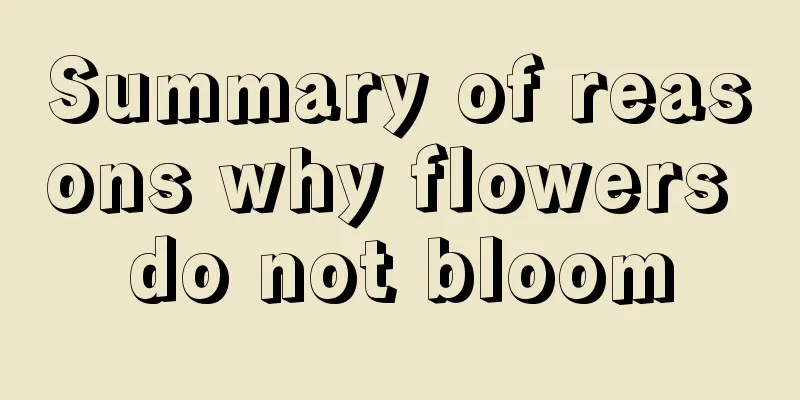Summary of reasons why flowers do not bloom

Summary of reasons why flowers do not bloomImproper water and fertilizerIf too much water and fertilizer are used during the growth period of plants, it will cause excessive growth of branches and leaves, and nutrients will accumulate in the roots, stems and leaves, resulting in insufficient nutrition for the flowers and fruits of the plants, affecting the development of flower buds, and causing the flowers to not bloom or bloom sparsely. Also, if a large amount of fertilizer is applied during the plant's bud formation period, or the amount of watering is unstable, it can easily cause the flower buds to fall off. On the contrary, if too little fertilizer and water are applied during the growth period of flowers, the plants will lack nutrients for growth, resulting in fewer flowers and poorer quality of flowers. Light temperatureDifferent flowers have different preferences and requirements for light and temperature. For example, some flowers like light, while others like partial shade; some flowers like warmth, while others prefer coolness. If the light and temperature are inappropriate during the plant's growth period, it may easily cause the plant to not bloom or the flower buds to fall off. Soil propertiesMost flowers prefer slightly acidic or neutral soil and do not like saline or alkali soil. Therefore, excessive salt and alkali content in the soil will also affect the growth and flowering of flowers. Winter room temperatureSince some flowers need to hibernate, if the indoor temperature is too high in winter, it will cause the plants to sprout and leaf out prematurely, resulting in nutrient consumption, which will lead to insufficient nutrients for the plants in the next year, weakening the flowers, making them smaller, falling off, or even not blooming. Too little pruningProper pruning and trimming should be carried out during the growth period of the plant. This can not only achieve an aesthetic effect, but also prevent the branches and leaves from consuming too much nutrients and affecting the flowering of the plant. Pest and disease damageFlowers are prone to diseases and pests during their growth period, which affect the growth and development of the plants and result in them not blooming. For the above situation, we should take timely defensive measures, carry out reasonable fertilization and watering, create a good growth environment, and avoid the situation where the plants do not bloom. |
<<: How to grow ginseng potted plants
>>: Methods for disinfecting soil for growing flowers at home
Recommend
The role and value of gentian
Medicinal value of gentian The rhizomes of gentia...
The growing environment and local conditions of mint
Mint Growth Environment and Conditions Mint prefe...
What flowers are suitable for planting in rural courtyards? What flowers are the most prosperous in the courtyard?
What flowers are suitable for planting in rural c...
How to plant potted creeper
Can it be potted? Potted creeper needs a larger f...
How to grow Lithops so that they get better and better?
Although Lithops is a relatively difficult succul...
Is the bird of paradise flower easy to grow? Is it suitable for home cultivation?
Is it easy to grow bird of paradise? Bird of Para...
How many times can sweet potatoes be planted in a year? How many days does it take from planting to harvesting?
How many seasons can sweet potatoes be planted in...
Cherry cutting time and method
Cherry cutting time Cherries are generally propag...
How to plant potatoes to achieve high yields Potato high-yield planting technology
Potatoes are a crop with extremely high yield per...
When is the best time to plant Chinese cabbage?
Chinese cabbage planting time There are many vari...
How to trim Podocarpus to look good
When is the right time to prune Podocarpus? Podoc...
Method for raising seedlings of chayote
1. Time It is important to choose the right time ...
Cultivation methods and precautions of lotus orchid
Cymbidium is easy to grow. It grows very fast, ha...
Seabuckthorn's growing environment and local conditions
Seabuckthorn Growth Environment and Conditions Se...
How to prune wood chrysanthemums and how to prune them during flowering
Wood chrysanthemum pruning time Wood chrysanthemu...









